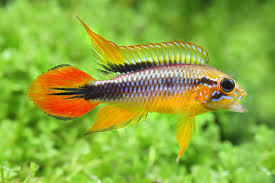1
/
of
1
Midwest Aquarium and Pond Supplier LLC
(128) Agassiz's Dwarf Cichlid
(128) Agassiz's Dwarf Cichlid
Regular price
$40.00 USD
Regular price
Sale price
$40.00 USD
Shipping calculated at checkout.
Quantity
Couldn't load pickup availability
The Agassiz's Dwarf Cichlid (Apistogramma agassizii) is a popular and colorful freshwater fish from the Amazon Basin of South America. Known for their distinctive black lateral band and varying vibrant colors, this dwarf cichlid is a great centerpiece for a planted community aquarium.
Tank and water requirements
- Tank size: A 20-gallon or larger tank is recommended for a pair or small group. For a community setup, a 30-gallon or larger is ideal to provide more territory and better water stability.
- Substrate: Use a fine, soft sand substrate. These cichlids are "micro-eartheaters" and enjoy sifting through the sand for food.
- Filtration: Opt for a filter that provides gentle but consistent flow. Sponge filters are an excellent choice because they provide good biological filtration without creating a strong current, which these fish dislike.
-
Water parameters:
- Temperature: Maintain a stable temperature between 72–86°F (22–30°C).
- pH: A slightly acidic to neutral pH range of 5.0 to 7.0 is ideal. For wild-caught specimens, softer, more acidic water is necessary.
-
Water quality:
Agassiz's Dwarf Cichlidsare sensitive to poor water quality. Keep ammonia and nitrite at 0 ppm and perform weekly partial water changes to keep nitrate levels low.
- Decorations: Provide plenty of hiding spots and visual barriers using driftwood, caves (like clay pots or coconut shells), and dense live plants. Floating plants can also help diffuse bright light, which they prefer.
Diet and feeding
- Carnivorous diet: These are micropredators that feed on small invertebrates in the wild.
-
Food types: A varied diet is key to maintaining vibrant colors and good health.
- Staple: High-quality pellets or flakes designed for carnivores.
- Supplements: Include frozen or live foods, such as bloodworms, brine shrimp, and daphnia.
- Feeding schedule: Feed small amounts two to three times per day to encourage natural foraging behavior.
Temperament and tank mates
- Temperament: While generally peaceful, males can become territorial, especially toward other males or during spawning. Keeping a single male with multiple females (a harem) can help spread out aggression in larger tanks.
-
Tank mates: Choose peaceful, non-aggressive species. Suitable companions include:
- Tetras (e.g., Neon, Ember, Rummy Nose)
- Corydoras catfish
- Pencilfish
- Rasboras
- Incompatible companions: Avoid larger, aggressive fish that might bully them, as well as dwarf shrimp and other small, delicate invertebrates that may become prey.
Breeding
- Cave spawners: Apistogramma agassizii are cave spawners, with the female guarding the eggs inside a cave.
- Parental care: The female will care for the eggs and fry, while the male defends the outer territory.
- Encouraging spawning: For best results, raise the tank temperature to around 77–82°F and provide slightly acidic water conditions.
Share
No reviews

